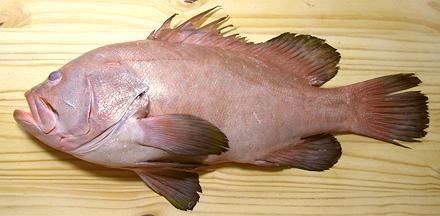 [Rooster Hind (fb); Hyporthodus acanthistius]
[Rooster Hind (fb); Hyporthodus acanthistius]
This East Pacific fish is found from California at the Mexican border south to Peru. It can grow to over 39 inches, but the photo specimen was 23 inches long and weighed about 6 pounds. This fish lives in depths between 150 and 300 feet and is subject to minor commercial harvest, but the population is decreasing. IUCN Red Listed as VU (Vulnerable).
More on the Grouper Family
This is a premium fish with a premium price. The flesh is very white and delicate in flavor. The texture is large flakes, but the overall texture can be firmer than for smaller groupers and doesn't flake apart as easily. There is enough connective tissue to hold fillets together very well for poaching, and it goes well with delicate sauces. By about 10 minutes of wet cooking fillets would be flaking apart, so this is not a fish for soups unless added in the last 5 minutes or so.
Pan frying fillets works well, with just a light powdering of rice flour, but they do not flake apart as easily on the plate as some fish, unless they're fried a bit longer.
Buying: The photo specimen was purchased from a Philippine market in Los Angeles for 2014 US $5.99 / pound. It was factory gutted - I don't say "factory cleaned" because only the easy stuff was removed. The gills, esophagus, tough swim bladder, heavy membranes and other hard to remove stuff was still inside.
Scales: This fish is completely covered with moderately large scales with moderate adhesion. They scrape off fairly easily with moderate flying about, but there may be a few that need to be shaved off.
Cleaning: This isn't the easiest fish to clean as there is a huge, very tough swim bladder and a lot of tough membranes inside. You'll want to cut the gill arches loose with your kitchen shears because they pull very hard, but even that isn't easy. You'll need a hefty pair of long nose pliers to pull a lot of this stuff out. As I mentioned above, this fish was factory gutted, but they only took out the easy stuff.
Fillet: This is not a difficult fish to fillet, but dive sharply under the collar because there's quite a bit of flesh there. When you get down to the rib cage it's easiest to cut the ribs from the backbone with kitchen shears and pull them from the fillet. There are some long sharp centerline spines for the length of the body cavity, but the cavity is short. You should pull them out with your long nose pliers. Pull straight forward as usual.
Yield: A 5 pound 12 ounce (factory gutted) fish yielded 2 pounds 12 ounces of skin-on fillet (48%) or 2 pounds 7-1/2 ounces skinless (43%).
Skin: The skin shrinks severely when cooked, so must be removed. Fortunately the skin is quite tough, so it's a relatively easy fish to skin using the usual long knife and cutting board Method. Filets are very wide, so I recommend cutting them in half along the centerline before skinning.
Stock: This is an excellent fish for stock. There will still be quite a bit of flesh left on the head, and especially on the bottom of the collar, which is difficult to recover due to the bones. Stock made from the head, fins and bones is mild and quite usable. I would not include the skins, which can impart a bitter taste. For details on making fish stock see our Fish Stock page.
sf_grouppkz 140226 - www.clovegarden.com